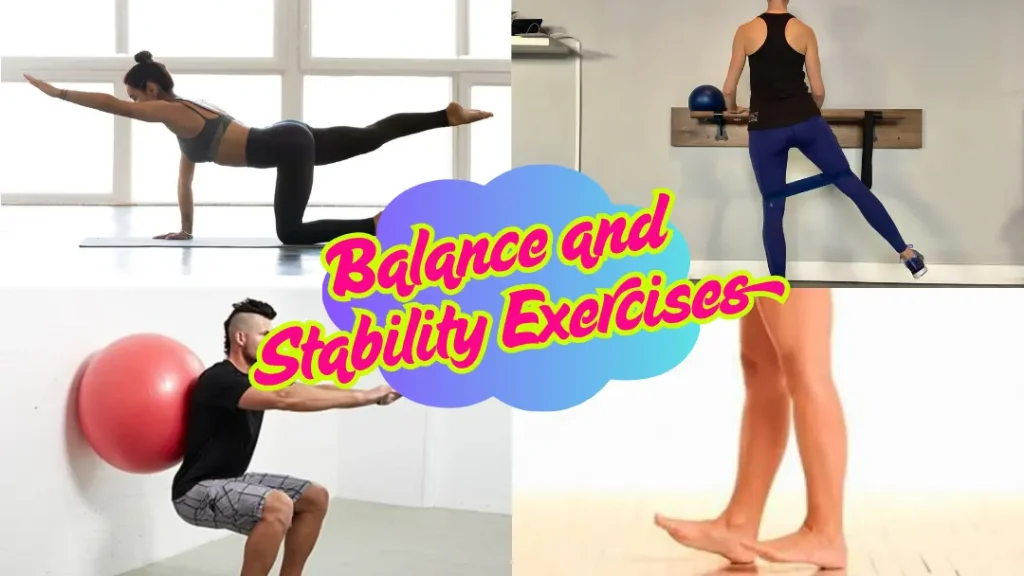7 Balance and Stability Exercises for Coordination and Strength

7 Balance and Stability Exercises
Balance and stability are key foundations of overall fitness, yet they’re often overlooked. Good balance helps you move confidently, avoid injury, and improve performance in everything from walking and lifting to yoga and sports.
Stability training targets your core, hips, and joints giving you better control over how your body moves. Whether you’re an athlete or just want to move more confidently, these exercises will help you stay grounded, steady, and strong.
Here are seven of the best moves to build better balance, coordination, and full-body control.
1. Single-Leg Stand
Improve Core Control and Ankle Stability
Stand tall and lift one foot off the ground. Hold for 30 seconds, then switch sides. To increase the challenge, close your eyes or stand on a soft surface like a folded towel.
How to do it:
- Keep your shoulders back and core tight
- Focus your gaze on a fixed point to stay steady
- Start with 10 to 15 seconds per leg and work up
This exercise strengthens your ankles, calves, and core while training your body to maintain alignment.
2. Heel-to-Toe Walk
Boost Balance and Coordination
Walk in a straight line, placing the heel of one foot directly in front of the toes of the other. It looks simple but requires focus, control, and core engagement.
How to do it:
- Keep your arms out to your sides for balance
- Move slowly and with control
- Try 10 to 15 steps in one direction, then return
3. Bird-Dog
Engage Core and Stabilize Your Spine
From a tabletop position on hands and knees, extend your right arm and left leg at the same time. Hold briefly, return to center, and switch sides.
How to do it:
- Keep your hips level and back flat
- Pause for 2–3 seconds at full extension
- Do 8 to 10 reps per side
4. Standing Side Leg Lifts
Strengthen Hips and Improve Lateral Balance
Stand upright and slowly lift one leg out to the side. Keep your torso tall and avoid leaning. Lower and repeat.
How to do it:
- Keep your toes facing forward
- Use a chair for support if needed
- Complete 10 to 12 reps on each side
5. Stability Ball Wall Squat
Build Core and Leg Strength with Control
Place a stability ball between your lower back and a wall. Squat slowly while keeping pressure on the ball. Return to standing with control.
How to do it:
- Keep your feet shoulder-width apart
- Go down until your thighs are parallel to the floor
- Perform 10 to 15 controlled repetitions
6. Reverse Lunges with Knee Drive
Add Dynamic Stability to a Classic Move
Step back into a reverse lunge, then push off the back foot and drive your knee up in front of you before stepping into the next rep.
How to do it:
- Use your arms for balance
- Keep your chest lifted and core braced
- Try 8 reps per leg
7. Toe Taps on an Elevated Surface
Train Control and Core Engagement
Stand in front of a step or low platform. Lightly tap one foot on the top, then switch quickly and repeat.
How to do it:
- Stay light on your feet
- Keep your back straight and arms moving
- Perform for 30 seconds and rest Ready to compare it to classic sports? Go back to Bungee Fitness vs Traditional Sports.
Tips for Better Balance Training
Make It Part of Your Weekly Routine
- Start with 2 to 3 sessions per week
- Do exercises barefoot when possible for more feedback
- Focus on quality, not speed
- Mix in both static (holding) and dynamic (moving) balance work
Frequently Asked Questions
Who should do balance and stability exercises?
Everyone from beginners to athletes can benefit. These exercises are especially helpful for older adults or those recovering from injury.
How often should I train balance?
Two to three times a week is a good starting point. Even short sessions help.
Can balance exercises help prevent falls?
Yes. They strengthen stabilizer muscles and improve coordination, which reduces the risk of falls.
Do I need equipment for these exercises?
Most moves can be done with bodyweight only. A stability ball, step, or yoga mat can add variety.
Should I warm up first?
Yes. Start with light movement to activate muscles and joints before doing focused balance work.
Conclusion
Balance and stability exercises might seem simple, but they’re powerful tools for improving strength, control, and confidence. By adding these seven moves into your routine, you’ll support your body from the ground up and move through life with better posture, fewer injuries, and more coordination.
